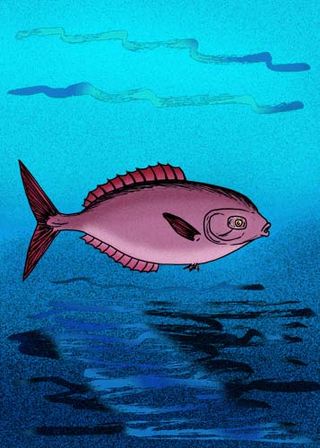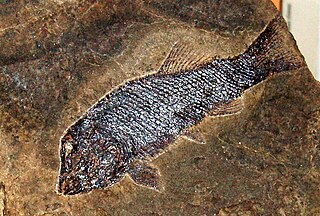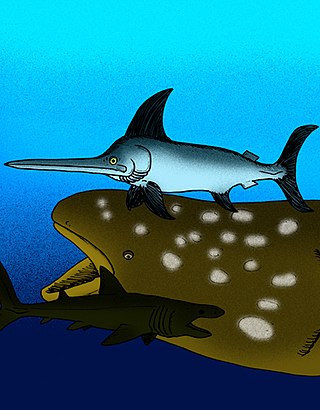
Beerichthys is an extinct genus of prehistoric marine ray-finned fish. It contains a single species, Beerichthys ingens, that was a member of the Ypresian London Clay fauna of lower Eocene England.
Eothynnus salmonens is an extinct species of prehistoric jackfish that lived during the lower Eocene of what is now the Isle of Sheppey (as a part of the London Clay Lagerstatten. It is known exclusively from some preserved skulls.
Acestrus is an extinct genus of prehistoric marine ray-finned fish that lived during the lower Eocene in Europe. It contains one species, A. ornatus from the London Clay, known from a single braincase. It is thought to possibly be closely allied with billfish based on the braincase morphology, although it remains uncertain whether it had the rostrum characteristic of billfishes. Some authorities have suggested blochiid affinities.
Bramoides is an extinct genus of marine ray-finned fish that lived during the lower Eocene. It contains a single species, B. brieni, known from the London Clay.
Aulopopsis is an extinct genus of prehistoric marine ray-finned fish that lived during the lower Eocene. It is considered a relative of lizardfish in the order Aulopiformes, but its exact taxonomic placement is uncertain. Some authorities place it with the Aulopidae, while others place it with the Giganturoidae.
Elopopsis is an extinct genus of prehistoric bony fish that lived from the Cenomanian to Campanian.
Salminops is an extinct genus of prehistoric bony fish that lived during the Cenomanian known from USA and Portugal.

Eubiodectes is an extinct genus of prehistoric bony fish that lived during the Cenomanian.
Enischorhynchus is an extinct genus of prehistoric bony fish that lived during the Turonian of southern Texas.
Oligopleurus is an extinct genus of prehistoric bony fish that lived during the Kimmeridgian stage of the Late Jurassic epoch.
Elpistoichthys is an extinct genus of prehistoric bony fish that lived during the Carnian stage of the Late Triassic epoch.

Aetheodontus is an extinct genus of prehistoric marine bony fish that lived during the early Ladinian stage of the Middle Triassic epoch of what is now Italy and Switzerland. It contains a single species, A. besanensis.
Acrognathus is an extinct genus of prehistoric bony fish belonging to the order Aulopiformes. Although no extensive systematic analysis has been performed, it is tentatively placed with the greeneyes in the family Chlorophthalmidae, making it the oldest representative of that family.

Ctenothrissa is a prehistoric genus of marine ray-finned fish in the order Ctenothrissiformes. It contains a number of species known from the Late Cretaceous of England and Lebanon.
Dinelops is an extinct genus of marine ray-finned fish from the Late Cretaceous. It contains a single species, D. ornatus, from the Cenomanian of England. It was initially and often continues to be classified in the Osmeroididae, a family of extinct elopomorph fish that are placed in either the Albuliformes or Elopiformes. However, other studies place Osmeroides in the Albuliformes and Dinelops in the Elopiformes.

Xiphiorhynchus is an extinct genus of prehistoric swordfish that lived from the Eocene until the Oligocene. Unlike the modern swordfish, both the upper and lower jaws of Xiphiorhynchus were extended into blade-like points.

Notagogus is an extinct genus of prehistoric bony fish. They can be found in the Solnhofen Plattenkalk.

Orthocormus is an extinct genus of prehistoric pachycormiform bony fish. It is known from three species found in Late Jurassic (Kimmeridgian) aged plattenkalk deposits in Bavaria, Germany. The species "Hypsocormus" tenuirostris Woodward 1889 from the late Middle Jurassic (Callovian) Oxford Clay is not closely related to the type species of Hypsocormus, and is more closely related to Orthocormus + Protosphyraena, and thus has sometimes been referred to in open nomenclature as Orthocormus? tenuirostris. The species of Orthocormus reached over a metre in length, and are thought to have been pelagic predators.
Orvikuina is an extinct genus of prehistoric bony fish.
Osorioichthys is an extinct genus of prehistoric bony fish.






